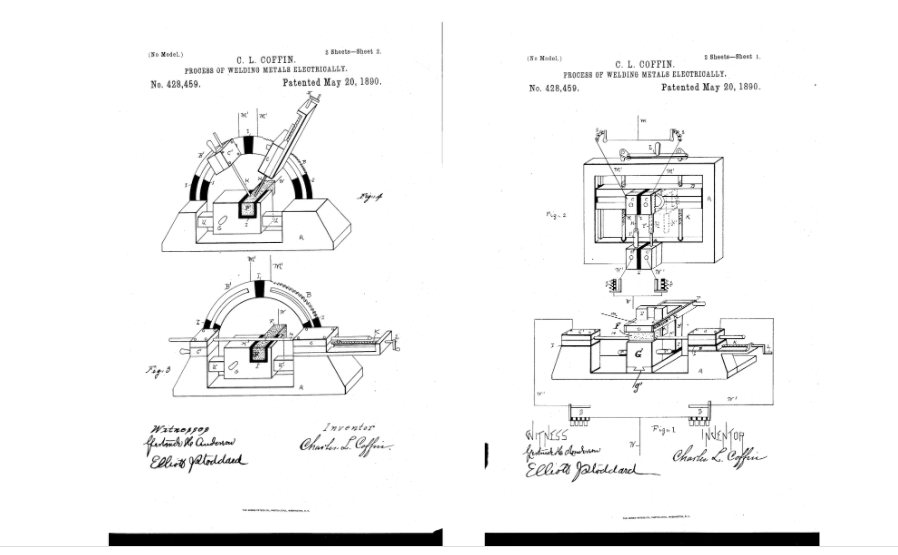HISTORY OF WELDING
FROM THE FIRST BRONZE AGE WELDING TO ENERGY BEAM WELDING
If our most distant ancestors could observe something as trivial to us as the resistance welding process by which two pieces of metal are tightly thermoelectrically joined without any material input, they would most likely think that it is a matter of witchcraft. We may find that welding is an especially recent technology. But the truth is that welding techniques have existed in our history for millennia.
In today’s article we are going to take a short journey through the history of welding. And we will discover that some of the techniques we use today are much older than we thought.
THE FRAGUES AND THE FIRST WELDS
 Iron Pillar of Delhi We have to travel many years back to find the origin of welding. We find it in the distant Bronze Age. About 2000 years ago, in the first forges, small gold boxes were already made with some pieces joined by pressure as a welding.
Iron Pillar of Delhi We have to travel many years back to find the origin of welding. We find it in the distant Bronze Age. About 2000 years ago, in the first forges, small gold boxes were already made with some pieces joined by pressure as a welding.
Later, during the Iron Age around 1000 BC, the Egyptians and the inhabitants of the Mediterranean area learned to weld the first pieces of iron. The technique was transferred to the Middle East and reached India, where the Iron Pillar of Delhi stands out. Built in 310 with welds in its process and weighing 5.4 tons.
A few centuries later, during the Middle Ages, there were important advances in forge welding. Blacksmiths developed various techniques to achieve a union of metals by repeatedly striking them while heating them. And in fact, in 1540, Vannoccio Biringuccio published “De la pirotechnia”, considered the first metallurgy manual with precise descriptions on forging and welding.
THE IMPORTANT TECHNOLOGICAL ADVANCES OF THE XIX CENTURY
It was not until the 19th century that technological advances were made in welding techniques. But the truth is that the last years of this century represented a great evolution for this process.
In 1800, the chemist Sir Humphry Davy discovered the electric arc, leading, at the end of the century, to the invention of arc welding thanks to the invention of metal electrodes by the Russian Nikolai Slavyanov and the American, C. L. Coffin.
Likewise, in 1885 Elihu Thomson registered the first resistance welding patent, improved over the next fifteen years. In 1893 thermite welding and gas welding were invented. And, a few years later, around 1900, the first applications with acetylene torches began.
 FOLLOW THE EVOLUTION DURING THE TWENTIETH CENTURY
FOLLOW THE EVOLUTION DURING THE TWENTIETH CENTURY
The First World War caused a great demand for armor and, therefore, welding. In Europe and America numerous companies emerged dedicated to the manufacture of welding machines and electrodes to meet the requirements of the contest. After the Great War, in 1919, twenty members of the Wartime Welding Committee of the Emergency Fleet Corporation, under the leadership of Comfort Avery Adams, founded the American Welding Society,
a non-profit organization dedicated to the advancement of welding. Precisely that same year, C.J Holslag invented alternating current welding. Although it would not be popular until the 1930s..
In 1920, P.O. Nobel invents automatic welding for General Electric. This automated welding system was used to build worn motor shafts and worn crane wheels. It was also used by the automotive industry to produce rear axle housings.
Although the automatic process that became really popular was submerged arc welding. Developed by the National Tube Company, it was used during the defense build-up in 1938 in shipyards and artillery factories. It is one of the most productive welding processes and is still popular today.
In 1941 Meredith perfected and patented gas tungsten arc welding (GTAW) based on an idea by Charles L. Coffin to weld in a non-oxidizing gas atmosphere, which he patented in 1890. And in 1948 he successfully developed the gas metal arc welding (GMAW) process at the Battelle Memorial Institute.
 Laser welding. A few years later, in 1953 Lyubavskii and Novoshilov announced the use of welding with consumable electrodes in an atmosphere of carbon dioxide gas. And, in 1957, there were two great advances: Robert Gage invented plasma arc welding and J.A. Stohr the process of electron beam welding.
Laser welding. A few years later, in 1953 Lyubavskii and Novoshilov announced the use of welding with consumable electrodes in an atmosphere of carbon dioxide gas. And, in 1957, there were two great advances: Robert Gage invented plasma arc welding and J.A. Stohr the process of electron beam welding.
Finally, during the 80’s, laser welding was invented, although at first it was rejected due to the high costs it entailed. In the early 90’s, a new process was developed that mixes the two types of welding as different as the MSG arc and the laser light.

Con más de 40 años de experiencia en el sector de la soldadura y las técnicas de unión Bearcat extiende sus conocimientos a todos los sectores industriales: automoción, ingeniería de ferrocarriles, ingeniería industrial, industria naval, obra civil.











